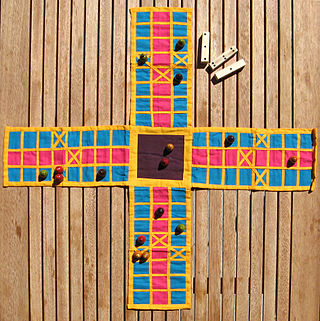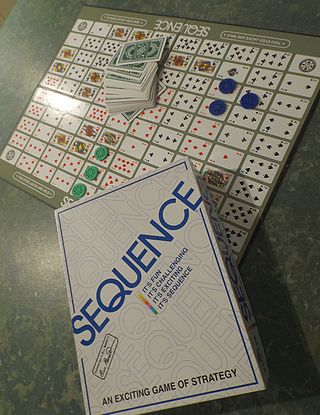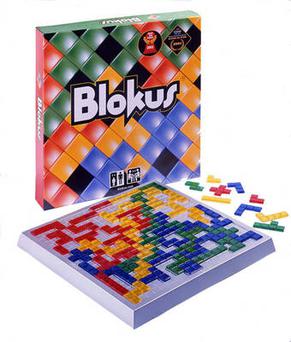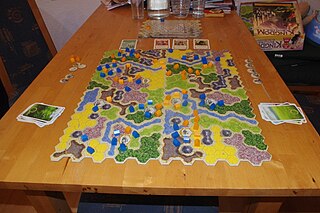Related Research Articles

Sternhalma, commonly known as Chinese checkers or Chinese chequers, is a strategy board game of German origin that can be played by two, three, four, or six people, playing individually or with partners. The game is a modern and simplified variation of the game Halma.

Tic-tac-toe, noughts and crosses, or Xs and Os is a paper-and-pencil game for two players who take turns marking the spaces in a three-by-three grid with X or O. The player who succeeds in placing three of their marks in a horizontal, vertical, or diagonal row is the winner. It is a solved game, with a forced draw assuming best play from both players.

Nine men's Morris is a strategy board game for two players dating at least to the Roman Empire. The game is also known as nine-man morris, mill, mills, the mill game, merels, merrills, merelles, marelles, morelles, and ninepenny marl in English. The game has also been called cowboy checkers and is sometimes printed on the back of checkerboards. Nine men's morris is a solved game, that is, a game whose optimal strategy has been calculated. It has been shown that with perfect play from both players, the game results in a draw.
Three men's morris is an abstract strategy game played on a three by three board that is similar to tic-tac-toe. It is also related to six men's morris and nine men's morris. A player wins by forming a mill, that is, three of their own pieces in a row.
Mak-yek is a two-player abstract strategy board game played in Thailand and Myanmar. Players move their pieces as in the rook in Chess and attempt to capture their opponent's pieces through custodian and intervention capture. The game may have been first described in literature by Captain James Low a writing contributor in the 1839 work Asiatic Researches; or, Transactions of the Society, Instituted in Bengal, For Inquiring into The History, The Antiquities, The Arts and Sciences, and Literature of Asian, Second Part of the Twentieth Volume in which he wrote chapter X On Siamese Literature and documented the game as Maak yék. Another early description of the game is by H.J.R. Murray in his 1913 work A History of Chess, and the game was written as Maak-yek.

Pachisi is a cross and circle board game that originated in Ancient India. It is described in the ancient text Mahabharata under the name of "Pasha". It is played on a board shaped like a symmetrical cross. A player's pieces move around the board based upon a throw of six or seven cowrie shells, with the number of shells resting with the aperture upward indicating the number of spaces to move.

Tafl games are a family of ancient Northern European strategy board games played on a checkered or latticed gameboard with two armies of uneven numbers. Most probably they are based upon the Roman game Ludus latrunculorum. Names of different variants of Tafl include Hnefatafl, Tablut, Tawlbwrdd, Brandubh, Ard Rí, and Alea Evangelii. Games in the tafl family were played in Norway, Sweden, Denmark, Iceland, Britain, Ireland, and Sápmi. Tafl gaming was eventually supplanted by chess in the 12th century, but the tafl variant of the Sámi people, tablut, was in play until at least the 18th century. The rules for tablut were written down by the Swedish naturalist Linnaeus in 1732, and these were translated from Latin to English in 1811. All modern tafl games are based on the 1811 translation, which had many errors. New rules were added to amend the issues resulting from these errors, leading to the creation of a modern family of tafl games. In addition, tablut is now also played in accordance with its original rules, which have been retranslated.

Trouble is a board game in which players compete to be the first to send four pieces all the way around a board. Pieces are moved according to the roll of a die using a contained device called a "Pop-O-Matic". Trouble was developed by the Kohner Brothers and initially manufactured by Irwin Toy Ltd., later by Milton Bradley. The game was launched in America in 1965. The classic version is now marketed by Winning Moves Games USA. The gameplay, board, and concept is derivative of the Indian board game Ludo.

Sorry! is a board game that is based on the ancient Indian cross and circle game Pachisi. Players move their three or four pieces around the board, attempting to get all of their pieces "home" before any other player. Originally manufactured by W.H. Storey & Co in England and now by Hasbro, Sorry! is marketed for two to four players, ages 6 and up. The game title comes from the many ways in which a player can negate the progress of another, while issuing an apologetic "Sorry!"
Martian Chess is an abstract strategy game for two or four players invented by Andrew Looney in 1999. It is played with Icehouse pyramids on a chessboard. To play with a number of players other than two or four, a non-Euclidean surface can be tiled to produce a board of the required size, allowing up to six players.

Sequence is an abstract strategy board-and-card game. Sequence was invented by Doug Reuter. He originally called the game Sequence Five. He spent years developing the concept, and, in June 1981, granted Jax Ltd. an exclusive license to manufacture, distribute and sell the board game Sequence and its subsequent variations. The game was first sold in a retail store in 1982. In 2017, Goliath Game Company bought Jax, and in early 2018 also bought all licensor rights and now owns 100% of the game Sequence. Doug Reuter is acknowledged as the inventor of Sequence on all newly produced copies of the game - both on the box and in the printed rules.

Djambi is a board game and a chess variant for four players, invented by Jean Anesto in 1975. The rulebook in French describes the game, the pieces and the rules in a humorous and theatrical way, clearly stating that the game pieces are intended to represent all wrongdoings in politics.

Blokus is an abstract strategy board game for two to four players, where players try to score points by occupying most of the board with pieces of their colour. The board is a square regular grid and the pieces are polyominoes. It was designed by French mathematician Bernard Tavitian and first released in 2000 by Sekkoïa, a French company. It has won several awards, including the Mensa Select award and the 2004 Teacher's Choice Award. In 2009, the game was sold to Mattel.
Medina is a board game designed by Stefan Dorra and published by Hans im Glück and Rio Grande Games in 2001. In the game, three or four players compete to be the most influential developer of Medina, a desert city near the Atlas Mountains in 1822. Variations of the game allow 2 or 5 players. The game was nominated for the 2001 Deutscher Spiele Preis and the 2003 Jeu de l'année, but won neither prize.

Tsuro is a tile-based board game designed by Tom McMurchie, originally published by WizKids and now published by Calliope Games.
Pasang is a two-player abstract strategy board game from Brunei. The game is often referred to as Pasang Emas which is actually a software implementation of the traditional board game. The object of this game is to acquire the most points by capturing black and white tokens on the board. Black tokens are worth 1 point, and white tokens are worth 2 points. The board is initially laid out with all 120 black and white tokens in one of over 30 traditional patterns. Players choose a piece called a "ka" which is used to capture the tokens on the board. Each player's "ka" moves around the board capturing as many tokens as possible. As a note, the "kas" are the only mobile pieces in the game. The other pieces are stationary, and are captured by the "kas". Players must capture token(s) during their turn, or lose the game. When all tokens have been captured from the board, the player with the most points is the winner. However, if there are any tokens left on the board, and none can be captured on a player's turn, then that player loses the game, and the other player is the winner.
Tiger and buffaloes is a two-player abstract strategy board game from Myanmar. It belongs to the hunt game family. The board is a 4x4 square grid, where pieces are placed on the intersection points and move along the lines. It is one of the smallest hunt games. Three tigers are going up against eleven buffaloes. The tigers attempt to capture as many of the buffaloes by the short leap as in draughts or Alquerque. The buffaloes attempt to hem in the tigers.
The fictional universe of the Discworld novels by Terry Pratchett features a number of invented games, some of which have gone on to spawn real-world variants.

Kingdom Builder is a strategy board game designed by Donald X. Vaccarino, published in 2011 by Queen Games with illustrations by Oliver Schlemmer in German, British and international versions.
References
- BoardGameGeek (2017), Description of Quod.